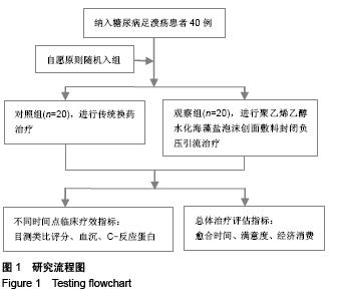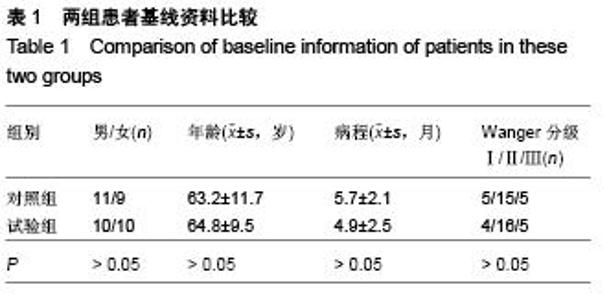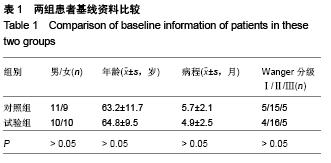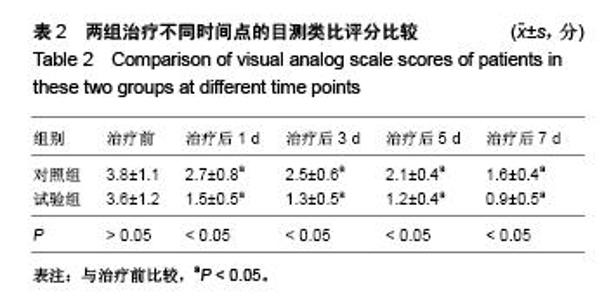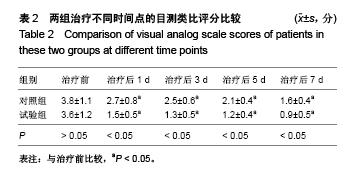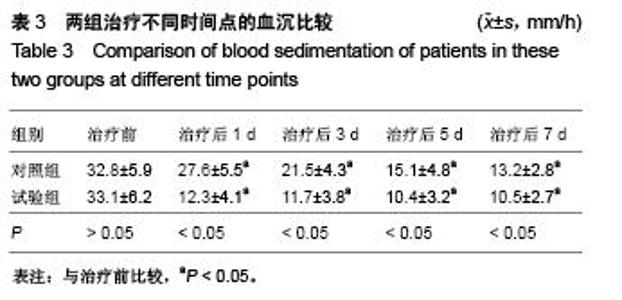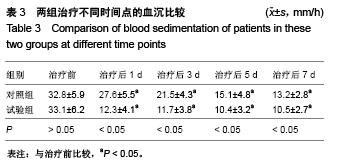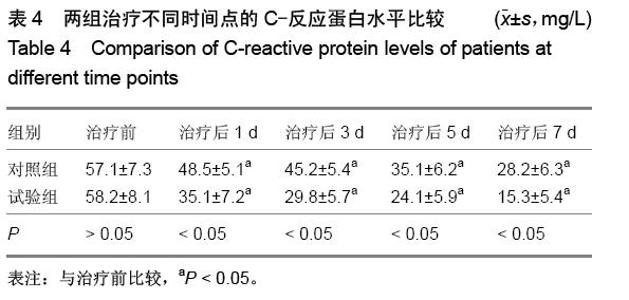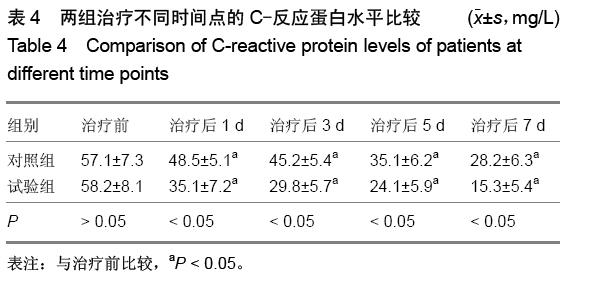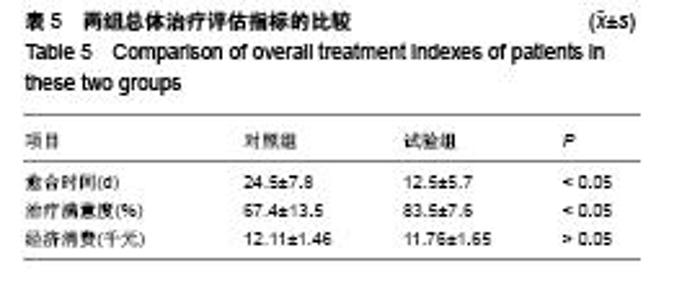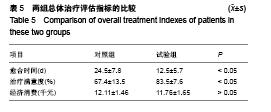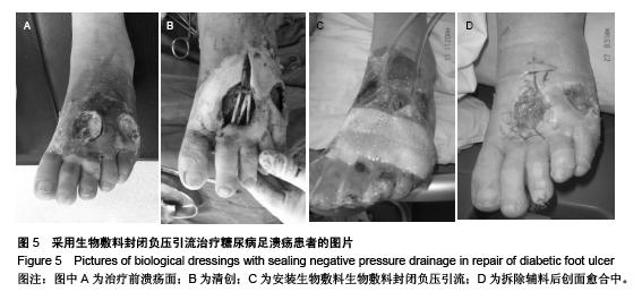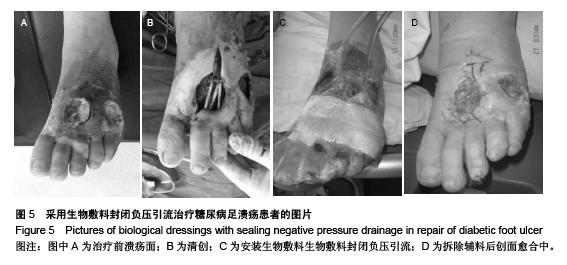Chinese Journal of Tissue Engineering Research ›› 2015, Vol. 19 ›› Issue (52): 8461-8466.doi: 10.3969/j.issn.2095-4344.2015.52.018
Previous Articles Next Articles
Polyvinyl alcohol hydration algae salt bubble wound dressings with sealing negative pressure drainage repair diabetic foot ulcers
Zhou Juan1, Chen Xiao-yun1, Yu Hong-mei2
- 1Department of Orthopedics, General Hospital of Nanjing Military Region of Chinese PLA, Nanjing 210002, Jiangsu Province, China; 2Department of Nursing, Tangshan Hospital, Nanjing General Hospital of Nanjing Military Command of PLA, Nanjing 211131, Jiangsu Province, China
-
Received:2015-11-05Online:2015-12-17Published:2015-12-17 -
Contact:Yu Hong-mei, Associate nurse in charge, Department of Nursing, Tangshan Hospital, Nanjing General Hospital of Nanjing Military Command of PLA, Nanjing 211131, Jiangsu Province, China -
About author:Zhou Juan, Senior nurse, Department of Orthopedics, General Hospital of Nanjing Military Region of Chinese PLA, Nanjing 210002, Jiangsu Province, China
CLC Number:
Cite this article
Zhou Juan, Chen Xiao-yun, Yu Hong-mei. Polyvinyl alcohol hydration algae salt bubble wound dressings with sealing negative pressure drainage repair diabetic foot ulcers[J]. Chinese Journal of Tissue Engineering Research, 2015, 19(52): 8461-8466.
share this article
| [1] Federer AE,Haughom BD,Levy DM,et al.Blastomyces Tenosynovitis of the Foot and Ankle: A Case Report and Review of the Literature.J Foot Ankle Surg.2015.pii: S1067-2516(15)00177-5.
[2] Avrahami R,Rosenblum J, Gazes M,et al.The Effect of Combined Ultrasound and Electric Field Stimulation on Wound Healing in Chronic Ulcerations.Wounds. 2015;27(7): 199-208.
[3] Hegewald KW,Wilder ML,Chappell TM,et al.Combined Internal and External Fixation for Diabetic Charcot Reconstruction: A Retrospective Case Series.J Foot Ankle Surg. 2015. pii: S1067-2516(15)00179-9.
[4] Desman E,Bartow W,Anderson LH.Human Skin Allograft for Patients With Diabetic Foot Ulcers, Venous Leg Ulcers, or Surgical/Traumatic Wounds Retrospective, Descriptive Study.Ostomy Wound Manage. 2015;61(7):16-22.
[5] Crawford F,Cezard G,Chappell FM,et al.A systematic review and individual patient data meta-analysis of prognostic factors for foot ulceration in people with diabetes: the international research collaboration for the prediction of diabetic foot ulcerations (PODUS).Health Technol Assess.2015;19(57): 1-210.
[6] Armstrong DG,Hurwitz BL, ipsky BA.Set Phages to Stun: Reducing the Virulence of Staphylococcus aureus in Diabetic Foot Ulcers.Diabetes.2015;64(8):2701-2703.
[7] Huang ET,Mansouri J,Murad MH,et al.A clinical practice guideline for the use of hyperbaric oxygen therapy in the treatment of diabetic foot ulcers.Undersea Hyperb Med. 2015;42(3):205-247.
[8] Huang E.Adjunctive hyperbaric oxygen therapy for diabetic foot ulcers: An editorial perspective.Undersea Hyperb Med. 2015;42(3):177-181.
[9] Delea S,Buckley C,Hanrahan A,et al.Management of diabetic foot disease and amputation in the Irish health system: a qualitative study of patients' attitudes and experiences with health services.BMC Health Serv Res.2015;15:251.
[10] Langer V,Bhandari PS,Rajagopalan S,et al.Negative pressure wound therapy as an adjunct in healing of chronic wounds.Int Wound J.2015;12(4):436-442.
[11] Qu J,Yan R,Wang L,et al.Free dermatoplasty combined with vacuum sealing drainage for the treatment of large-area soft tissue defects accompanied by bone exposure in the lower leg.Exp Ther Med.2013;5(5):1375-1380.
[12] Yang YH,Jeng SF,Hsieh CH,et al.Vacuum-assisted closure for complicated wounds in head and neck region after reconstruction.J Plast Reconstr Aesthet Surg. 2013;66(8): e209-216.
[13] Liu L,Tan G,Luan F,et al.The use of external fixation combined with vacuum sealing drainage to treat open comminuted fractures of tibia in the Wenchuan earthquake.Int Orthop.2012; 36(7):1441-1447.
[14] Beno M,Martin J,Hatzl J.Vacuum sealing in the treatment and prevention of prosthetic infections--a case review.Rozhl Chir. 2010;89(8):508-512.
[15] Moch D,Fleischmann W,Russ M.The BMW (biosurgical mechanical wound treatment) in diabetic foot.Zentralbl Chir.1999;124 Suppl 1:69-72.
[16] Lazzarini PA,O'Rourke SR,Russell AW,et al.Reduced Incidence of Foot-Related Hospitalisation and Amputation amongst Persons with Diabetes in Queensland, Australia. PLoS One.2015;10(6):e0130609.
[17] Shaked G,Czeiger D,Abu Arar A,et al.Intermittent cycles of remote ischemic preconditioning augment diabetic foot ulcer healing.Wound Repair Regen. 2015;23(2):191-196.
[18] Lew EJ,Mills JL Sr,Armstrong DG.The deteriorating DFU: prioritising risk factors to avoid amputation.J Wound Care. 2015;24(5 Suppl 2):31-37.
[19] Chadwick P,McCardle J.Assessing infected ulcers: a step-by-step guide.J Wound Care.2015;24(5 Suppl 2):15-19.
[20] Shi B,Sun J,Cao Y,et al.Application of vacuum sealing drainage to the treatment of seawater-immersed blast-injury wounds.Int Wound J.2015.doi: 10.1111/iwj.12444.
[21] Wang J,Zhang H,Wang S.Application of vacuum sealing drainage in the treatment of internal fixation instrument exposure after early postoperative infection.Minerva Chir. 2015;70(1):17-22.
[22] Tang J, Guo WC, Yu L,et al.Clinical efficacy of artificial skin combined with vacuum sealing drainage in treating large-area skin defects.Chin J Traumatol. 2010;13(5):289-292.
[23] Sermoneta D,Di Mugno M,Spada PL,et al.Intra-abdominal vacuum-assisted closure (VAC) after necrosectomy for acute necrotising pancreatitis: preliminary experience.Int Wound J. 2010;7(6):525-530.
[24] Williams ML, Holewinski JE.Use of a human acellular dermal wound matrix in patients with complex wounds and comorbidities.J Wound Care.2015;24(6):261-262,264-267.
[25] Ruppert V.Commentary on 'Strategies for Free Flap Transfer and Revascularisation with 10 Year Outcome in the Treatment of Large Diabetic Foot Lesions'.Eur J Vasc Endovasc Surg. 2015;50(2):231.
[26] Wu L, Hou Q, Zhou Q,et al.Prevalence of risk factors for diabetic foot complications in a Chinese tertiary hospital.Int J Clin Exp Med.2015;8(3):3785-3792.
[27] Chiwanga FS, Njelekela MA.Diabetic foot: prevalence, knowledge, and foot self-care practices among diabetic patients in Dar es Salaam, Tanzania - a cross-sectional study. J Foot Ankle Res.2015;8:20.
[28] Ghaderian SB,Hayati F,Shayanpour S,et al.Diabetes and end-stage renal disease; a review article on new concepts.J Renal Inj Prev.2015;4(2):28-33.
[29] Rankin TM,Miller JD,Gruessner AC,et al.Illustration of Cost Saving Implications of Lower Extremity Nerve Decompression to Prevent Recurrence of Diabetic Foot Ulceration.J Diabetes Sci Technol.2015;9(4):873-880.
[30] Rerkasem K,Kosachunhanun N,Sony K,et al. Underrecognized Peripheral Arterial Disease in Patients With Diabetes Mellitus in Thailand: We Must Consider Neuroischemic Foot Ulcers From This Fallout.Int J Low Extrem Wounds.2015;14(2):132-135.
[31] Butt DA,Hester T,Bilal A,et al.The medial column Synthes Midfoot Fusion Bolt is associated with unacceptable rates of failure in corrective fusion for Charcot deformity: Results from a consecutive case series.Bone Joint J.2015;97-B(6):809-813.
[32] Rodgers KE,Bolton LL,Verco S,et al. NorLeu<sup>3</sup> -Angiotensin (1-7) [DSC127] as a Therapy for the Healing of Diabetic Foot Ulcers.Adv Wound Care (New Rochelle). 2015; 4(6):339-345.
[33] Harindhanavudhi T,Parks A,Mauer M,et al.Podocyte Structural Parameters Do Not Predict Progression to Diabetic Nephropathy in Normoalbuminuric Type 1 Diabetic Patients. Am J Nephrol.2015;41(4-5):277-283.
[34] Marx RC,Mizel MS.What's New in Foot and Ankle Surgery.J Bone Joint Surg Am. 2015;97(10):862-868.
[35] Caruana L,Formosa C,Cassar K.Prediction of wound healing after minor amputations of the diabetic foot.J Diabetes Complications.2015;29(6):834-837. |
| [1] | Chen Ziyang, Pu Rui, Deng Shuang, Yuan Lingyan. Regulatory effect of exosomes on exercise-mediated insulin resistance diseases [J]. Chinese Journal of Tissue Engineering Research, 2021, 25(25): 4089-4094. |
| [2] | Chen Yang, Huang Denggao, Gao Yuanhui, Wang Shunlan, Cao Hui, Zheng Linlin, He Haowei, Luo Siqin, Xiao Jingchuan, Zhang Yingai, Zhang Shufang. Low-intensity pulsed ultrasound promotes the proliferation and adhesion of human adipose-derived mesenchymal stem cells [J]. Chinese Journal of Tissue Engineering Research, 2021, 25(25): 3949-3955. |
| [3] | Yang Junhui, Luo Jinli, Yuan Xiaoping. Effects of human growth hormone on proliferation and osteogenic differentiation of human periodontal ligament stem cells [J]. Chinese Journal of Tissue Engineering Research, 2021, 25(25): 3956-3961. |
| [4] | Sun Jianwei, Yang Xinming, Zhang Ying. Effect of montelukast combined with bone marrow mesenchymal stem cell transplantation on spinal cord injury in rat models [J]. Chinese Journal of Tissue Engineering Research, 2021, 25(25): 3962-3969. |
| [5] | Gao Shan, Huang Dongjing, Hong Haiman, Jia Jingqiao, Meng Fei. Comparison on the curative effect of human placenta-derived mesenchymal stem cells and induced islet-like cells in gestational diabetes mellitus rats [J]. Chinese Journal of Tissue Engineering Research, 2021, 25(25): 3981-3987. |
| [6] | Hao Xiaona, Zhang Yingjie, Li Yuyun, Xu Tao. Bone marrow mesenchymal stem cells overexpressing prolyl oligopeptidase on the repair of liver fibrosis in rat models [J]. Chinese Journal of Tissue Engineering Research, 2021, 25(25): 3988-3993. |
| [7] | Liu Jianyou, Jia Zhongwei, Niu Jiawei, Cao Xinjie, Zhang Dong, Wei Jie. A new method for measuring the anteversion angle of the femoral neck by constructing the three-dimensional digital model of the femur [J]. Chinese Journal of Tissue Engineering Research, 2021, 25(24): 3779-3783. |
| [8] | Meng Lingjie, Qian Hui, Sheng Xiaolei, Lu Jianfeng, Huang Jianping, Qi Liangang, Liu Zongbao. Application of three-dimensional printing technology combined with bone cement in minimally invasive treatment of the collapsed Sanders III type of calcaneal fractures [J]. Chinese Journal of Tissue Engineering Research, 2021, 25(24): 3784-3789. |
| [9] | Qian Xuankun, Huang Hefei, Wu Chengcong, Liu Keting, Ou Hua, Zhang Jinpeng, Ren Jing, Wan Jianshan. Computer-assisted navigation combined with minimally invasive transforaminal lumbar interbody fusion for lumbar spondylolisthesis [J]. Chinese Journal of Tissue Engineering Research, 2021, 25(24): 3790-3795. |
| [10] | Hu Jing, Xiang Yang, Ye Chuan, Han Ziji. Three-dimensional printing assisted screw placement and freehand pedicle screw fixation in the treatment of thoracolumbar fractures: 1-year follow-up [J]. Chinese Journal of Tissue Engineering Research, 2021, 25(24): 3804-3809. |
| [11] | Shu Qihang, Liao Yijia, Xue Jingbo, Yan Yiguo, Wang Cheng. Three-dimensional finite element analysis of a new three-dimensional printed porous fusion cage for cervical vertebra [J]. Chinese Journal of Tissue Engineering Research, 2021, 25(24): 3810-3815. |
| [12] | Wang Yihan, Li Yang, Zhang Ling, Zhang Rui, Xu Ruida, Han Xiaofeng, Cheng Guangqi, Wang Weil. Application of three-dimensional visualization technology for digital orthopedics in the reduction and fixation of intertrochanteric fracture [J]. Chinese Journal of Tissue Engineering Research, 2021, 25(24): 3816-3820. |
| [13] | Sun Maji, Wang Qiuan, Zhang Xingchen, Guo Chong, Yuan Feng, Guo Kaijin. Development and biomechanical analysis of a new anterior cervical pedicle screw fixation system [J]. Chinese Journal of Tissue Engineering Research, 2021, 25(24): 3821-3825. |
| [14] | Lin Wang, Wang Yingying, Guo Weizhong, Yuan Cuihua, Xu Shenggui, Zhang Shenshen, Lin Chengshou. Adopting expanded lateral approach to enhance the mechanical stability and knee function for treating posterolateral column fracture of tibial plateau [J]. Chinese Journal of Tissue Engineering Research, 2021, 25(24): 3826-3827. |
| [15] | Zhu Yun, Chen Yu, Qiu Hao, Liu Dun, Jin Guorong, Chen Shimou, Weng Zheng. Finite element analysis for treatment of osteoporotic femoral fracture with far cortical locking screw [J]. Chinese Journal of Tissue Engineering Research, 2021, 25(24): 3832-3837. |
| Viewed | ||||||
|
Full text |
|
|||||
|
Abstract |
|
|||||
